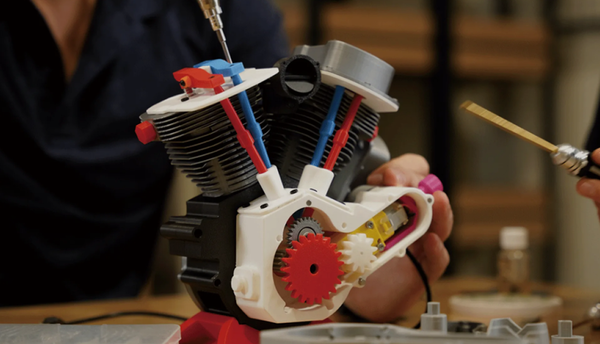To open, or not to open, that is the question

In the last few days, on various occasions, we were asked the same question, "Is the system open or closed?" People showed their concern about the RFID for our filament, on the slicer, on the proprietary hot end, and also on the seemingly new firmware. This is actually a very good question and it’s certainly worth a blog article to discuss in detail.
It absolutely makes sense that the community puts so much attention on this "open or closed" question because in the past decade, it is ultimately the openness of 3D printing community that has pushed desktop 3D printing forward. The true heroes are those behind Reprap, Marlin, Cura, Prusa, Slic3r, Hypercube, Voron, and Klipper; the list could go on and on for another page. The standardized nozzle interface, 1.75mm filament, motor driver boards, and even the old school STL format empowers the community to share, providing a vast and solid ecosystem. Bambu Lab is a newcomer in 3D printing; we started our R&D work by diving into the rich heritage accumulated by all the available open projects and standardized parts. Whenever we face a choice between an open/standard design and a proprietary design, we always ask ourselves, "Is it worth it?” Sometimes the conclusion is to keep things open, and sometimes, it is to close things up, and I am going to discuss all the major choices we have made so far.
1. Filament: It would be very stupid if it were not open.
Everyone showed their concern when they saw RFID in the system, asking whether the filament is a closed system. We believe that it would be supremely stupid to make a closed filament system. There are so many materials, colors, surface finishes, compounds, and blends out there. No single company could fulfill the diverse needs of the 3D printing community. Using a closed filament system would mean that a printer is crippled from day one.
With this in mind, we followed the standard 1.75mm filament design. The AMS is designed to hold the 1kg spools that most filament manufacturers use. Based on our test, more than 90% of 1kg spools are compatible with the AMS. If you have a very special spool, you can always hang it on the back of the printer and bypass the AMS.
2. Hotend: we chose a proprietary hotend to boost performance.
There are very difficult choices to make to choose between a standard hotend and a proprietary design. This topic is worth a dedicated article, and you can find it here. Long story short, we made a high performance proprietary hotend, and made the price very reasonable, so our users will not feel being locked in by our system.
3. Slicer: It will be open, both ways.
When we talk about slicer openness, there are actually three questions:
A. Is the printer open to third party slicers?
B. Is the slicer open to third party printers?
C. Is the slicer open source?
A. Is the printer open to third party slicers?
Partially, yes. The X1 series can read standard Gcode. This means that the gcode exported from any third-party slicer can be executed by an X1. With a proper printer profile, you can use any third-party slicer to slice models and print with X1. However, there are some limitations because the X1 series has some special features that need to be taken care of by the slicer. Some of the loosely integrated features such as ABL, auto flow calibration and active vibration compensation can still be activated by third-party slicers. All you need to do is to add the proper start-Gcode in the slicer. Some other features, which need in-print actions, will be difficult to activate, such as first layer scanning.
B. Is the slicer open to third party printers?
It will be, and this is related to the third question.
C. Is the slicer open source?
The slicer part of Bambu Studio will be open source. Here is the plan. Bambu studio is a combination of four parts.
1)A slicer that is based on Slic3r/Superslicer/Prusaslicer; we heavily modified it to include some new algorithms and tricks.
2)A project manager to integrate slicing profiles, project instructions, bom lists and the sourcing link, pictures, manuals, and license information with the model.
3)A BambuLab connection utility to control BambuLab printers via an encrypted data link and get feedback, including data and video.
4) Cloud componentsto connect Bambu Studio to the Bambu Cloud.
We are obligated to open-source Part 1 because of the open-source license. Our plan is to combine Parts 1 and 2 together and open source them as a project-based slicer which works as a stand-alone application on local computers and is compatible with most third-party printers. This should make a small contribution to the community as well. Both the new slicing algorithm and the project-based approach should be very handy. The thought behind this approach is that Parts 1 and 2 are what the community needs. To open-source Parts 3 and 4, there would be a tremendous amount of work to do, and there is very little the community would gain, since both rely on proprietary infrastructures such as printers and cloud servers. We would like to ask for the understanding of the community to give us some time before we open-source Parts 1 and 2, which is scheduled for the second half of this year. Right now, our software developers are working hard to fix bugs in Bambu studio, and I would like to give them some time to segment the whole studio properly before opening the source code of Parts 1 and 2.
4. Firmware and circuit board: This is closed source.
For this part, we decided to keep these items as property of the company. The firmware is 100% developed in-house and we would like to keep it that way to be competitive on the market. We do have 100+ employees, and this number is growing. We want to make our business successful so that we can provide for each of our employees.
5. Patent: This is open to the community but closed for commercial use.
All of our patents, designs, methods, and tricks are open to the open-source community. We learned a lot from the community, and we would like to give all our knowledge back to the community. This does not apply to commercial usage, however, and the reason is the same as that mentioned in the firmware question: we need to be able to compete and take care of our employees. There will be one exception: in the case that something unfortunate happens to our company, and we cannot not survive anymore, we will open-source everything to everyone. In that situation, third party companies could manufacture spare parts, and the community would be welcome to maintain software for our users. I sincerely hope this never happens, though, because we intend to survive and thrive.
These are all my thoughts about the question of "to open or not to open" for now.
2022/05/29
Dr Turbo




